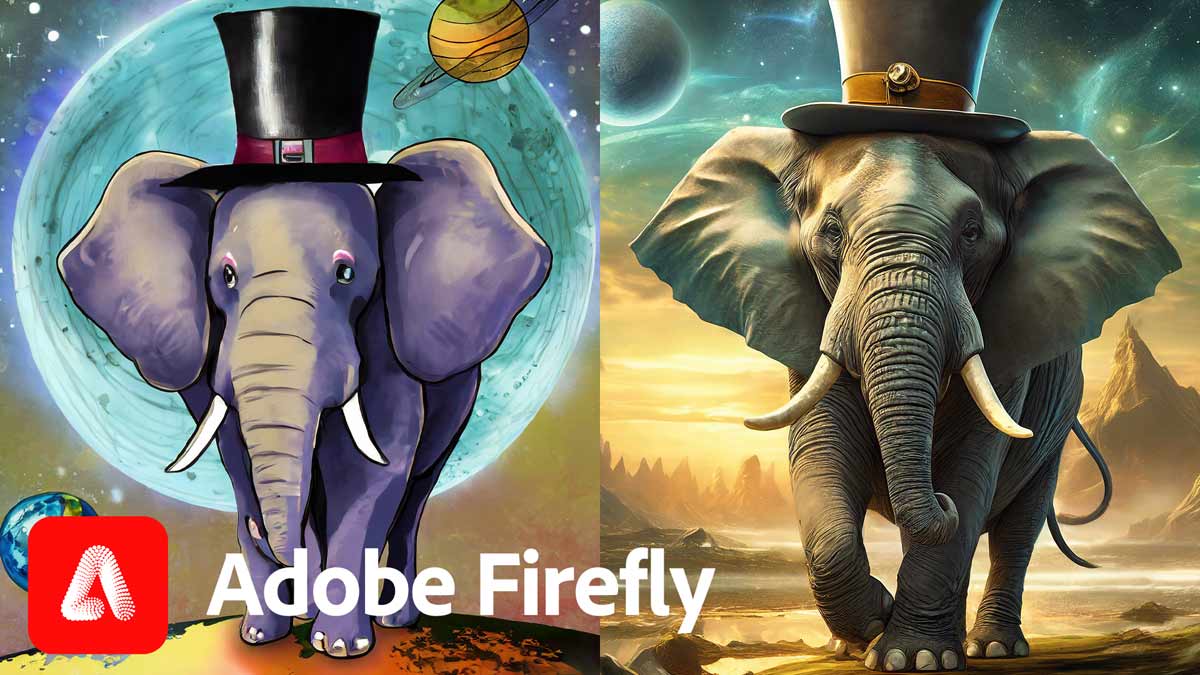
Learn how to use Adobe Firefly’s Visual Intensity setting to adjust the amount of detail and complexity in Firefly’s AI images.
Download the PDF: Adobe Firefly – Using Visual Intensity for More Detailed Images
Written by Steve Patterson.
Adobe Firefly has lots of options that can be combined with your prompt to adjust the look and style of your AI images. I covered two of them, Structure Reference and Style Reference, in my previous tutorial.
But there’s one option in Adobe Firefly called Visual Intensity that has the biggest impact on the amount of detail and complexity in the images. By default, Visual Intensity is set to 50 percent, which is why Firefly’s results don’t always look as detailed or as impressive as you might expect.
In this tutorial, I show you where to find Visual Intensity in Firefly and how to adjust it. And we’ll try out a few prompts to see how the Visual Intensity setting affects the results, including how to add more detail and drama to your images, or create more simplistic and less detailed images when you need them.
How to access Adobe Firefly
To use Adobe Firefly’s text-to-image generator, open your web browser and visit the Firefly website (firefly.adobe.com). Then scroll down the page and select the text-to-image module.
You’ll need a free or premium Firefly plan or an active Creative Cloud subscription to use Adobe Firefly.
Let’s get started!
Where to find Adobe Firefly’s Visual Intensity option
All of Adobe Firefly’s options for adjusting the look and style of your images are found in the column along the left.

The Adobe Firefly image options.
The Visual Intensity slider is found in the Styles section. By default, the slider is set to the middle (50 percent).

Firefly’s Visual Intensity slider.
Entering a prompt
To see how Visual Intensity affects Firefly’s images, I’ll leave it set to 50 percent to start with and I’ll enter a prompt.
For my prompt, I’ll try a furry cat sitting on a window ledge looking out the window.

Entering a prompt in Adobe Firefly.
Then I’ll click Generate.

Clicking the Generate button.
The initial Firefly results
Adobe Firefly generates four images that we can choose from. With Visual Intensity at 50 percent, the initial results don’t look too bad.
Here’s one of the results. We have our cat, sitting on a window ledge, looking out the window.
But I wouldn’t say that this image is all that interesting. The cat looks realistic but the window looks fairly generic. Also, it’s tough to see what the cat is looking at through the window because everything outdoors is blurred out.

One of the initial Firefly results with Visual Intensity at 50 percent.
Lowering Visual Intensity to simplify the images
You can drag the Visual Intensity slider to the right to increase the amount of detail and complexity in Adobe Firefly’s images.
But before we do that, I’m going to reduce Visual Intensity to its lowest setting by dragging the slider all the way to the left.

Lowering Firefly’s Visual Intensity setting.
I’ll keep the same prompt and click Generate again.
This time, with Visual Intensity lowered, we get results that are even less detailed than what we started with. The cat still looks okay but there’s really nothing else going on in this image. The window is about as simple as it could be, and there’s even less to look at outdoors.
It’s important to note that Firefly’s Visual Intensity setting has nothing to do with the resolution of the image. Less detail
does not mean lower resolution
. In fact, the resolution has not changed. Instead, Firefly has generated a simplified version of the image with fewer visual elements.

Same prompt but with Visual Intensity lowered.
Increasing Visual Intensity for more detail
Now that we’ve tried lowering the Visual Intensity setting, I’ll increase Visual Intensity to its highest setting by dragging the slider all the way to the right.

Increasing the Visual Intensity setting.
Again I’ll keep the same prompt and click Generate.
This time, with Visual Intensity increased, Firefly generates much more interesting and dramatic results. In this example, the window is more detailed, there’s a mountain landscape scene outdoors that wasn’t there before, and even the lighting is better.
So again it’s not a matter of increasing the resolution. All three results we’ve looked at share the same resolution. The difference is that higher Visual Intensity settings add a whole new level of complexity to Firefly’s images.

Same prompt again but with Visual Intensity increased.
A second Visual Intensity example
Let’s look at a couple more quick examples of the impact that Firefly’s Visual Intensity setting has on the results.
For my second prompt, I’ll try a group of dogs sitting around a table playing cards.
This time Firefly decided to generate an image that looks more like a painting or illustration, which is fine. I’ll show you how to change that in a moment. But with Visual Intensity at 50 percent, it sure doesn’t look very detailed.

Second prompt, Visual Intensity at 50 percent.
However, with Visual Intensity lowered, Firefly generates an even less detailed and much simpler version of the image.
In fact, it’s almost like we’ve lowered Firefly’s intelligence here because we now have cards stuck to the wall in the background.

Second prompt, lowest Visual Intensity setting.
But with Visual Intensity at its highest setting, the result looks much more detailed and complex.
This image is much closer to the result I was hoping for initially.

Second prompt, highest Visual Intensity setting.
Adobe Firefly’s Content Type option
Another way to generate results with more detail is to set Firefly’s Content Type option to Photo. By default it’s set to Auto which allows Firefly to choose between Photo or Art.
I’ll choose Photo and then click Generate again.

Setting the Content Type to Photo.
This time, instead of results that look like a painting, Firefly generates a much more photorealistic image.

Same prompt, same Visual Intensity setting, Content Type set to Photo.
A final Visual Intensity example
Let’s look at one more example of how Visual Intensity affects the results.
For my final prompt, I’ll enter an elephant wearing a top hat on an alien world.
With Visual Intensity at 50 percent, the result looks pretty good. We have an elephant, he’s wearing a top hat, and he’s definitely on some alien planet.

Third prompt, default Visual Intensity setting.
Compare that with Visual Intensity at its lowest setting where the result is so simple, it might belong in a children’s book.
Of course, if that’s the look you wanted then this result would be great.

Third prompt, lowest visual intensity.
But by increasing Visual Intensity to the highest setting, we get a much more detailed and dramatic result.
I really like the elephant’s hat in this one, but I think the entire image looks great.

Third prompt, highest visual intensity.
And there we have it! That’s how to control the amount of detail and complexity in your images using the Visual Intensity slider in Adobe Firefly.
Related tutorials:
Don’t forget, all of my Photoshop tutorials are available to download as PDFs.
Source: PhotoshopEssentials
